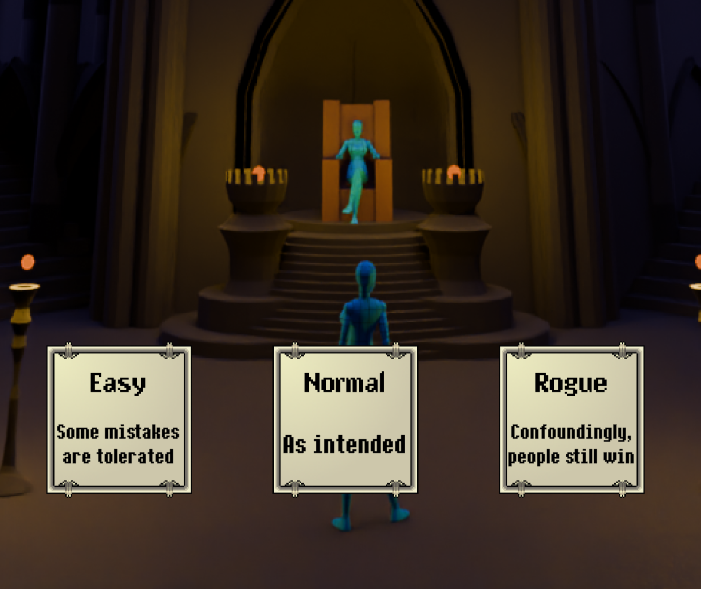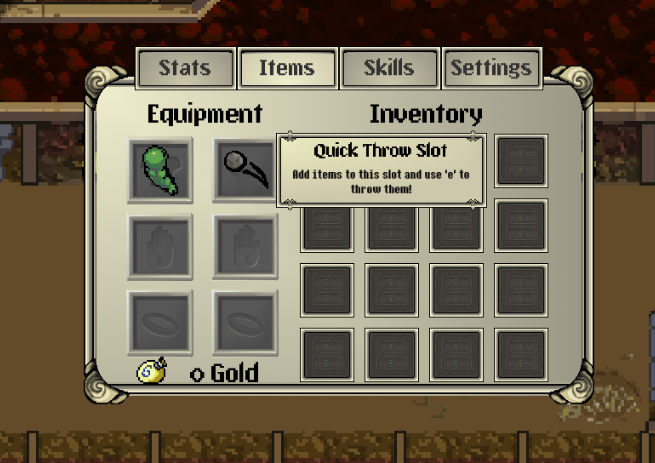September 2025 Dev Update
ROC Game Fest
Good news! We got the game in front of some real people this weekend at ROC Fest, Rochester's statewide Game Development Festival. Nearly 100 players got their hands on the newly minted gamepad support for 100 Rogues, entering the Bandit Hole and learning the basics of combat. The crowd was as diverse as can be, with people brand new to games all the way to folks who consume Roguelike content like breathing.
First, it was so incredibly motivating to get to talk with so many gamers and see their reactions to playing the game. As ever, there has been high praise for the game's artwork, and couple of players scheduled their day about finding time to play longer.
This crop of completely new players gave a great opportunity to revisit our onboarding / tutorial experience, as well as opportunities to revise our UI, as well as an opportunity to talk about 100 Rogues' goals with its difficulty settings.
The Goal of 100 Rogues
100 Rogues original elevator pitch was, in part, "make a roguelike that modern audiences can understand." Thankfully, genre trappings like permadeath are so commonplace in indie games that a lot of our work has been done for us by popular gaming.
At the risk of starting Roguelike versus Roguelite debates, it is important to note that traditional roguelikes are unique in one expectation: the average player giving the average effort will likely never see the end credits. That's okay! That's truly not a judgment of our players' skill levels. Progress is a slow, steady process of reading situations and learning to intuit our RNG. If you know the exact chance of finding a Tower Shield, you be able to learn when it's worth taking the Heavy Armaments skill, for example.
Players approaching our game ought to have the expectation set that chasing a high score is The Point of playing.
You might die 100 times in the Dungeon before you get to the boss. If half of those were a Personal Best score, then you are playing correctly, and finally getting to the boss is proof of how much you've learned.
So, emphasizing the leaderboards and really rewarding the player for their achievement is our goal in correctly setting players expectations for the experience of playing 100 Rogues.
The Tutorial
But outside of those high level gameplay concepts, the Traditional Roguelike is still a hard sell for a lot of players. Pokemon Mystery Dungeon was a familiar point of entry for a few of our players, but for the most part players had a predeliction to approaching the game like a classic Zelda game (which isn't a coincidence, since those games were a clear inspiration for the game's perspective).
For the Ouya port, we had a separate tutorial level explaining the basics of combat, unlocking skills, loot, etc.. This was actually the least-effort approach for a lot of technical reasons I can't get into, but in general, this is not how players approach games anymore. One of the most in-depth Let's Plays of 100 Rogues' Ouya port shows the player jumping right into the game and fumbling for several minutes just to figure out how to make a basic melee attack! The tutorial was his next stop, but the average player will find this a frustrating and tedious extra step.
So, for Steam, we will be integrating the tutorials into gameplay, with the assumption that players will jump in assuming they can learn as they go. As a simple, easy first effort, these controls diagrams will be accessible from the main menu. While this is a good start, “Quick Throw Slot” doesn’t explain the relationship this button has with the Equipment Menu or the quality of life purpose it serves. Even “Target Attack” is oversimplified, as the button is superfluous for melee attacks and the explanation is insufficient to describe the differences between targeting behaviours of ranged and melee weapons.
So, to go one very important step further and solve those problems, we will be implementing contextual tutorial panels that force the player through critical interactions like making attacks, purchasing skills, or using the radial menu. These can be hard to get right, and can be very annoying if they are unwelcome or obtrusive, so it's important to be patient and careful in implementing them.
I posted last month about the game's difficulty, and this is the entire solution. "The game is not difficult, you just need to know how to play it!" is a frequent chorus in difficulty discourse in games. It is entirely true, and the game's developer has a clear, strong responsibility to ensure the process of learning how to play is fun, not frustrating or confusing.
The tutorial should give just enough guidance that the interface no longer stands in your way, without ever robbing the experience of building up knowledge and strategies. We need to give players a gentle push and a clear heading into the game, and with it, the confidence to play and learn on their own.
Future Development
The Expo this weekend was an opportunity for players to approach the games in a lot of ways I didn't expect them to, which naturally resulted in me finding a lot of bugs I didn't realize existed. Alongside the tutorial implementation, I will be entering a thorough QA phase to look for remaining critical issues.
Once I am confident that the game is stable and accessible as well as complete, we will launch a Demo on Steam. This is likely not going to be in October, but expect to see it available for play in November or early December.
I am really looking forward to the opportunity to share the joy players felt this weekend with you.
Regarding Difficulty
Our difficulty selection tries to be as honest as possible about the experiences provided.
I’ll be totally honest, here. I’m bad at videogames. I’m especially bad at roguelikes. You’d think that programming these monsters, looking over their stats day in, day out, would give me a solid leg up in how to get past them. But the sad, embarrassing truth is: I’ve never scored an honest victory in 100 Rogues, even on Easy Mode. Now that I’ve completely dashed all credibility I have on the subject, I want to reassure you: I’m the programmer. I assume Keith Burgun, the game’s designer, can beat the game handily, even on Normal difficulty.
But why can’t I clear a run? Why do I always die somewhere around the Dungeon? There’s a few reasons.
Part of it, at least in the current iteration of the game, is Map layout. When transitioning from the iOS version to the Ouya version, one of the key redesign goals was to open up the maps to reduce the prevalence of bottle-necking strategies in ideal play, and to speed up gameplay. I may have overshot, and started producing maps that make finding cover almost impossible. This is especially fatal in the Dungeon world, where Skeleton Archers deal massive damage, usually guarded by too many Skeletons.
Our inspiration for map design. Note that moving from one tile to the next in Rogue takes .05 seconds, and in 100 Rogues it takes .4, because of animations. This was unacceptably slow
There’s another, far more important reason I lose so often, though: I’m just careless and lazy. I know how dangerous it is to get into Melee range against a Knight; each hit has a fair chance at stun-locking you until whatever is in the area sops up your remaining health like bread over runny egg yolk. But I still do it a lot! Why is that?
The reason is, I play in a way that feels more natural to me. Throwing a grenade might be the right choice for the predicament I’m in, but if I have to go into a menu, change a tab, click an item, click a button, and then select a target, I’m just going to run in and smack a thing.
So UX counts for a lot. The game’s design philosophy started out with the intention to emphasize player skills, but the key ingredient to survival really is about proper item and equipment management. While Ranged play is the steak and potatoes of the Wizard’s and Scoundrel’s kit, you need to be throwing items constantly no matter what class you are.
So it’s been critical to find ways to improve the UX to make it as effortless as possible to throw items. On iOS, we added quick slots along the bottom of the UI, creating priority items that can be used at any time. On PC, we have the real estate to put your entire inventory is in Quick Slots. I went one step further, though, and added a new Equipment Slot specifically for thrown items.
Check it out! New slot!
Now when you get a big stack of items that are optimal for throwing, like arrows or rocks or throwing knives, they can be assigned to this item slot. From there, a keybinding allows you to throw the items stacked in this slot as easily as targeting any other skill in the game.
So that’s an example of how I’m trying to make sure the User Interface aligns with the optimal ways to play the game. The winning strategy should not require a huge number of interactions to implement.
This isn’t the only approach to managing the game’s difficulty, although it is just about the only one I can make without fundamentally changing the game’s design. Keith designed 100% of all balance considerations for Normal difficulty, as far as player and enemy stats, loot tables and drop rates, and boss behaviour. And it is very, very difficult; even when following the optimal strategies, a single mistake or a bit of bad luck with enemy placement can end an otherwise fantastic run in an instant.
Since a key design goal for the game was accessibility, Easy mode was implemented as a compromise. The biggest changes in this area are the player starting stats and stat regenerations values, but certain other balance considerations were made. One of the most notable is the second boss fight, which only has half the functional enemy spawners on Easy Mode.
It is still my opinion that Easy Mode is far too punishing for players that want to understand what we’re going for in terms of strategy and skill progression, but don’t need to spend hundreds of hours internalizing enemy stats, damage types, spawning probabilities, loot table statistics, etc..
Fairy Wizard Redesign
Updates on the newly redesigned visuals for the Fairy Wizard Class in 100 Rogues, a traditional roguelike releasing to Steam in 2026!
Wizard’s visual redesign firmly establishes her as a Fae, a pixie-like waif of a warrior built for channeling arcane power and playing dirty tricks on those who deserve it (everyone, in 100 Rogues). Still giving the gothy teen vibe, she’s delivering more snark, more sass, more boorish badassery than ever before.
This also further emphasizes her low HP and health regeneration. While she can equip basic shields to mitigate some damage, her survivability depends entirely on avoiding damage and cleansing herself of debuffs in the very narrow window where catastrophe can still be avoided.
Slow enemies as they approach with Amafyst’s crystal caltrops. Summon the crystal ball (your only friend) to bulwark oncoming opponents. And if all else fails, teleport to safety.
Properly specializing the Wizard is more important than any other player class. Without the right long-term strategies to keep the necessary energy, her power will diminish and she will be picked off in just a few hits. But, the right synergies can have you leaping through space, raining destructive force down before enemies can form a plan.








